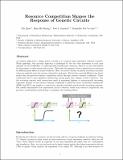Resource Competition Shapes the Response of Genetic Circuits
Author(s)
Qian, Yili; Huang, Hsin-Ho; Jimenez Zarco, Jose I.; Del Vecchio, Domitilla
DownloadACS.pdf (924.1Kb)
PUBLISHER_POLICY
Publisher Policy
Article is made available in accordance with the publisher's policy and may be subject to US copyright law. Please refer to the publisher's site for terms of use.
Terms of use
Metadata
Show full item recordAbstract
A common approach to design genetic circuits is to compose gene expression cassettes together. While appealing, this modular approach is challenged by the fact that expression of each gene depends on the availability of transcriptional/translational resources, which is in turn determined by the presence of other genes in the circuit. This raises the question of how competition for resources by different genes affects a circuit's behavior. Here, we create a library of genetic activation cascades in E. coli bacteria, where we explicitly tune the resource demand by each gene. We develop a general Hill-function-based model that incorporates resource competition effects through resource demand coefficients. These coefficients lead to nonregulatory interactions among genes that reshape the circuit's behavior. For the activation cascade, such interactions result in surprising biphasic or monotonically decreasing responses. Finally, we use resource demand coefficients to guide the choice of ribosome binding site and DNA copy number to restore the cascade's intended monotonically increasing response. Our results demonstrate how unintended circuit's behavior arises from resource competition and provide a model-guided methodology to minimize the resulting effects. Keywords: activation cascade; context dependence; genetic circuit; model-guided design; modularity; resource competition
Date issued
2017-07Department
Massachusetts Institute of Technology. Department of Mechanical EngineeringJournal
ACS Synthetic Biology
Publisher
American Chemical Society (ACS)
Citation
Qian, Yili et al. “Resource Competition Shapes the Response of Genetic Circuits.” ACS Synthetic Biology 6, 7 (April 2017): 1263–1272 © 2017 American Chemical Society
Version: Author's final manuscript
ISSN
2161-5063
2161-5063